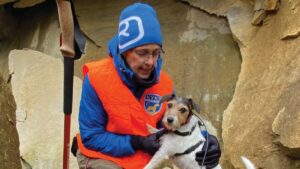
AKC Humane Fund ACE Award Winner – Search and Rescue Dog: Pocket
Interview with Jennifer Jordan Hall, the handler of “Pocket,” AKC Humane Fund ACE Award Winner – Search And Rescue Dog.

Home » Dog Sports » Search and Rescue Dog Sport
Search and Rescue (SAR) as a dog sport involves training and testing dogs in skills that are essential for locating missing persons in various environments. This discipline serves not only as a competitive activity, it also has practical applications in real-life search and rescue operations, showcasing the incredible abilities of dogs in several disciplines such as scent work, tracking, and area searches.
In SAR activities, dogs are trained to locate individuals based on scent, whether it’s in wilderness, urban, or disaster settings. As a sport, it involves various aspects of search and rescue work, including air-scenting, where dogs locate a scent in the air, and tracking or trailing, where dogs follow a ground scent trail.
Key skills in Search and Rescue include the dog’s ability to pick up and follow a human scent, work through distractions, and indicate the location of the found person to the handler. Training for SAR is intensive and ongoing, focusing on developing the dog’s natural scenting abilities, stamina, and discipline to work in challenging environments.
While many breeds can be trained for Search and Rescue (SAR) work, those with strong scenting abilities and physical endurance, such as German Shepherd Dogs, Bloodhounds, Labrador Retrievers, Belgian Malinois, Beagles, Basset Hounds, English Springer Spaniels, and Coonhounds, are commonly used. However, success in SAR is more about the individual dog’s capabilities and temperament rather than its specific breed.
SAR dogs undergo rigorous training that can take years to complete. They are trained to work in various conditions and terrain, and their handlers also receive specialized training. Certification for SAR dogs typically involves passing tests that simulate real search scenarios and demonstrate the dog’s proficiency in locating missing persons.
While SAR as a sport involves training and testing dogs in their search and rescue skills, many SAR dogs and their handlers also participate in actual SAR operations. They may work with law enforcement, emergency services, or volunteer organizations to find a missing person, contributing their vital skills to these life-saving missions.
Search and Rescue as a dog sport is a remarkable testament to the capabilities of dogs and their handler-partners. It not only provides a challenging and rewarding activity for the dogs, it also prepares them for critical roles in real-world SAR operations, highlighting the invaluable contributions dogs make in saving human lives.
The practice of using dogs for Search and Rescue (SAR) has historical roots that stretch back centuries, evolving from practical survival skills to a structured sport and an essential service in modern emergency response missions.
The use of dogs in search and rescue can be traced back to a time when the dog’s keen senses, particularly its sense of smell, were utilized for tracking and hunting as a means of providing a source of food. This innate ability was later adapted for locating missing persons and survivors of natural disasters. Most notably, breeds such as the St. Bernard became synonymous with rescue work, finding lost or injured travelers throughout Europe’s Alpine regions.
The formalization of Search and Rescue as a structured activity began as communities recognized the value of trained dogs in locating missing persons in their local communities, both urban and rural. This led to the development of training programs focused on enhancing the dog’s natural tracking and scenting abilities for real-world life-saving rescues. Today, SAR rescue teams are deployed at a moment’s notice whenever a natural disaster or police-related incident results in a missing person or people.

Interview with Jennifer Jordan Hall, the handler of “Pocket,” AKC Humane Fund ACE Award Winner – Search And Rescue Dog.

"*" indicates required fields
Showsight Magazine–the world’s most influential purebred dog publication since 1992. Each issue reaches a global audience dedicated to preserving the history and health of purpose bred dogs. Filled with award-winning editorial focused on news and insights from the dog show community, top breeders, handlers, AKC Judges, and more!